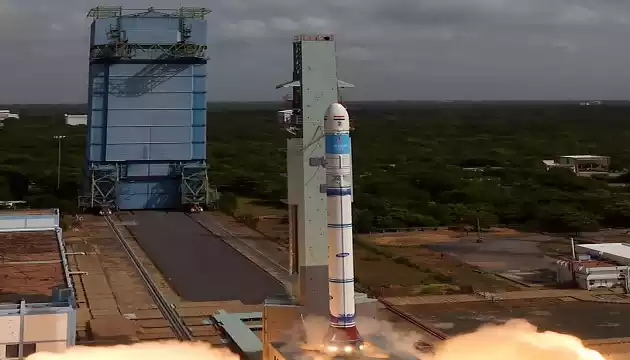EOS-08 Mission: The Indian Space Research Organisation (ISRO)’s Earth Observation Satellite EOS-08 was launched by the SSLV-D3 today from Satish Dhawan Space Centre, Shriharikota.
The main objectives of the EOS-08 mission is designing and developing a microsatellite, creating payload instruments compatible with the microsatellite bus, and incorporating new technologies required for future satellites.
Built on the Microsat/IMS-1 bus, EOS-08 carries 3 payloads as Electro Optical Infrared Payload (EOIR), Global Navigation Satellite System-Reflectometry payload (GNSS-R), and SiC UV Dosimeter.
The EOIR payload is designed to capture images in the Mid-Wave IR (MIR) and Long-Wave IR (LWIR) bands, during the day and night, for applications like satellite-based surveillance, disaster monitoring, environmental monitoring, fire detection, volcanic activity observation, and industrial and power plant disaster monitoring.
The GNSS-R payload determines the capability of using GNSS-R-based remote sensing for applications like as ocean surface wind analysis, soil moisture assessment, cryosphere studies over the Himalayan region, flood detection, and inland waterbody detection.
The spacecraft mission configuration is set to operate in a Circular Low Earth Orbit (LEO) at an altitude of 475 km with an inclination of 37.4°, and has a mission life of 1 year. The satellite has a mass of approximately 175.5 kg and generates power of around 420 W. It interfaces with the SSLV-D3 launch vehicle.
EOS-08 marks a significant advancement in satellite mainframe systems such as an Integrated Avionics system, known as the Communication, Baseband, Storage, and Positioning (CBSP) Package, which combines multiple functions into a single, efficient unit.
This system is planned with cold fired systems using commercial off-the-shelf (COTS) components and evaluation boards, supporting up to 400 Gb of data storage. Additionally, the satellite includes a structural panel embedded with PCB, an embedded battery, a Micro-DGA , an M-PAA (Phased Array Antenna), and a flexible solar panel, each serving as key components for onboard technology demo.
The satellite pays a reduced design in its Antenna Pointing Mechanisms, capable of achieving a rotational speed of 6 degrees per second and maintaining a pointing accuracy of ±1 degree.
The shrank phased array antenna further enhances communication capabilities, while the flexible solar panel incorporates a foldable solar panel substrate, GFRP tube, and CFRP honeycomb rigid end panel, offering improved power generation and structural integrity.
A pyrolytic graphite sheet diffuser plate, known for its high thermal conductivity of 350 W/mK, reduces mass and finds application in various satellite functions. Furthermore, the EOS-08 mission adopts a new method of integrating housekeeping panels using a hinge-based fixture, significantly reducing the duration of the Assembly, Integration, and Testing (AIT) phase.
The EOS-08 mission improves satellite technology through X-band data transmission, utilizing pulse shaping and Frequency Compensated Modulation (FCM) for X-Band data transmitters.
The satellite’s battery management system employs SSTCR-based charging and bus regulation, sequentially including or excluding strings at a frequency of 6 Hz.
(SOURCE: PIB)
You May Like
Trending Searches Today |
EOS-08 Mission: ISRO launches Earth Observation Satellite successfully
All Odisha villages plan to get 4G mobile service within a year


